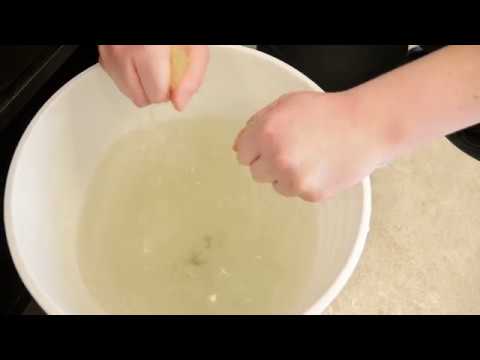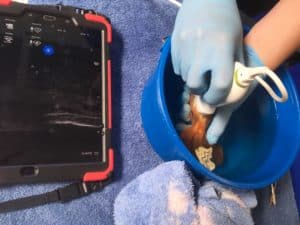Do fish get sick and need a visit from the veterinarian?
Absolutely YES! The responsibility with owning a pet doesn’t extend just to cats and dogs. If you are the proud owner of a fish, don’t you want to keep him/her happy and healthy? Since it’s hard to bring a fish to the vet for a checkup, we bring the vet to you! Aquatic Veterinary Services was established to bring quality home care to your aquatic pets.
Fish and other aquatic animals get sick like any land animal. There are specific bacterial, protozoal and viral diseases that can affect them. Fish transmit diseases mainly through the water they swim in, which is why it is important to keep their water clean and healthy. Owning a fish is a lot of work, but no different than being responsible for a cat or dog. Cleaning a fish tank isn’t as big a deal as you may think and your fish will thank you for it!
How do you know a fish is sick?
There are many physical and behavioral signs of sick fish. Your fish won’t lie down and take a nap or cough when they’re feeling lousy. They may not swim around as much and just sit on the bottom of their tank. Or they may not be able to swim to the bottom or top of their tank. Some disease manifests as external spots of discoloration or open wounds. Fraying fins anywhere on the body is another sign to look for. Prominent or thick gills, sticking further out from the body wall, is a sign of gill disease or poor water quality. Sometimes a fish won’t look sick at all and just die unexpectedly. Remove any dead fish from the tank ASAP. If you think your fish is sick, or one ends up dead with no signs, it is important to check both the tank and your other fish for signs of disease.
How do you diagnose disease in fish?
When a fish is sick, the first and most important place to check is its tank’s water quality. Poor water quality can cause fish to get sick more easily, because they are swimming in contaminated water. Stress occurs in fish, just like any animal by the production of the stress hormone, cortisol. The increased production of cortisol can decrease a fish’s natural immune system and make them more susceptible to disease. The most important water quality parameters to check are temperature, ammonia and dissolved oxygen. The temperature a fish likes can vary widely and it is important to know before you put a fish in its new tank. Cold water fish do not like tropical vacations. It is important to check your tank water temperature daily and make adjustments accordingly. Do not change the temperature on your fish tank if your fish is sick to “warm them up” or “cool them down.” Make adjustments ONLY to keep the temperature within the correct range for their species.
Ammonia is a natural waste product of fish and needs to be removed from the system by water changes. The nitrogen cycle is an important aspect of any fish tank. Bacteria in the water convert ammonia from fish waste to nitrite and nitrate. These need to be removed from the water or they can make your fish very sick. “Brown blood disease” or methemoglobinemia can be caused by too much nitrite in your fish’s water. Nitrite binds with the hemoglobin in your fish’s red blood cells and takes the place of oxygen, making it very hard for your fish to get enough oxygen in their system. A fish will end up suffocating no matter how much oxygen is in the system.
Dissolved oxygen in the tank water is how your fish breathes. Fish need oxygen in their water in order to take it up in their gills. If your tank water is stagnant, fish may use up all their available oxygen and suffocate. It is important to have an air stone or bubbler in your tank and make sure your tank has a strong enough circulation pump to move all the water in the tank around.
There are other water quality parameters to look at, but these are the top three big ones to check.
Okay, so the water quality is okay, what’s next?
If your tank water is okay, the next step is to perform basic diagnostics on a few fish from the tank. If any have died, it is important to perform a necropsy and look for any internal signs of disease. A necropsy is the fish equivalent of a human autopsy, and looks at causes of death. Live fish are anesthetized using a special, water-soluble chemical agent, and a skin scrape and gill clip are performed. A skin scrape is very simple and checks the external protective mucous of a fish. This barrier is the first line of defense for a fish’s immune system and is where many pathogens are trapped. Open wounds can also be checked by this method to look for signs of bacterial infection.
Gill clips may sound painful, but fish are anesthetized for this procedure and only a tiny, miniscule sample is taken. The fish may bleed for a few minutes post-procedure, but no adverse effects are seen. A lot of parasites like to hide in the gills because it gives them access to the nutrient-rich fish blood without having to enter the fish. Fish gills are a lot like human lungs. Humans can try to cough up pathogens, but this is not the case in fish. Both skin disease and gill disease can be treated through the water or oral medications.
So if the skin scrape and gill clip are inconclusive, what other diagnostics can you perform?
There are many more diagnostic procedures that can be performed. If your fish is having problems swimming, floating or getting flipped upside down, a swim bladder infection may be to blame. A fish’s swim bladder helps it stay neutrally buoyant in the water column and not have to swim up and down all the time. If you’ve ever been SCUBA diving, the swim bladder is equivalent to a buoyancy compensation device (BCD). Bacteria and other pathogens can get into the swim bladder and make a nice, happy home. This is not nice for the fish, however. A needle can be inserted into the swim bladder and a sample of the bacteria removed. Appropriate antibiotics can then be prescribed to treat the infection.
Surgery can also be performed on fish! You may think that all surgery is performed in dry environments, but fish can be anesthetized and surgically operated on as well! A chemical agent is dissolved in water that can be circulated over the fish’s gills using a regular tank circulation pump. They are kept moist by sitting on a foam pad soaked in water. Sometimes surgery is simple. If a fish swallowed a rock from the bottom of its tank, a simple pair of forceps can reach in and pull it out. Other times, say a fish with a cancerous tumor, surgery is not so simple. Fancy goldfish, the ones with the bubbles on their head, need regular procedures to make sure they can see. Surgery is very similar to procedures performed on a dog or cat, just on a smaller scale.
In conclusion, fish are just as susceptible to disease as any other animal. It is important to prevent disease as best you can by keeping their water clean. If you have the space to quarantine new fish, this may save you some trouble if a new fish or live plants brings new disease into your tank. To find a qualified aquatic veterinarian in your area, visit the American Association of Fish Veterinarians or the World Aquatic Veterinary Medical Association.




thank you so much!
Pingback: Top 5 Fish Mistakes – #5: Not Recognizing Problems – Aquatic Veterinary Services
Your article explained more nomenclature about any other articles Ive found on the internet so far. Very good and informative. Jeff Cagle
INFORMATIVE ARTICLE. THAX SO MUCH